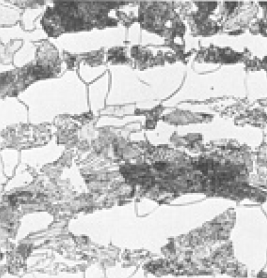Annealing Review - Heat Treatment
Metals and Materials Table of Contents
Annealing is the term denoting heat treatment that consists of heating to and holding at a suitable temperature followed by cooling at an appropriate rate, primarily for the softening of metallic materials. Generally, in plain carbon steels, annealing produces a ferrite-pearlite microstructure.
Steels may be annealed to facilitate cold working or machining, to improve mechanical or electrical properties, or to promote dimensional stability. The choice of an annealing treatment that will provide an adequate combination of such properties at minimum expense often involves a compromise. Terms used to denote specific types of annealing applied to steels are descriptive of the method used, the equipment used, or the condition of the material after treatment.
 |
|---|
A fully annealed 1020 steel showing a ferrite-pearlite microstructure. Etched in 4% picral plus 2% nital. 5OO×
Stages of annealing: There are three stages in the annealing process, with the first being the recovery phase, which results in softening of the metal through removal of crystal defects (the primary type of which is the linear defect called a dislocation) and the internal stresses which they cause. Recovery phase covers all annealing phenomena that occur before the appearance of new strain-free grains.The second phase is recrystallization, where new strain-free grains nucleate and grow to replace those deformed by internal stresses. If annealing is allowed to continue once recrystallization has been completed, grain growth will occur, in which the microstructure starts to coarsen and may cause the metal to have less than satisfactory mechanical properties.
Annealing in a controlled atmosphere: The high temperature of annealing may result in oxidation of the metal’s surface, resulting in scale. If scale is to be avoided, annealing is carried out in an oxygen, carbon, and nitrogen-free atmosphere (to avoid oxidation, carburization, and nitriding respectively) such as endothermic gas (a mixture of carbon monoxide, hydrogen gas, and nitrogen.The magnetic properties of mu-metal (Espey cores) are introduced by annealing the alloy in a hydrogen atmosphere.